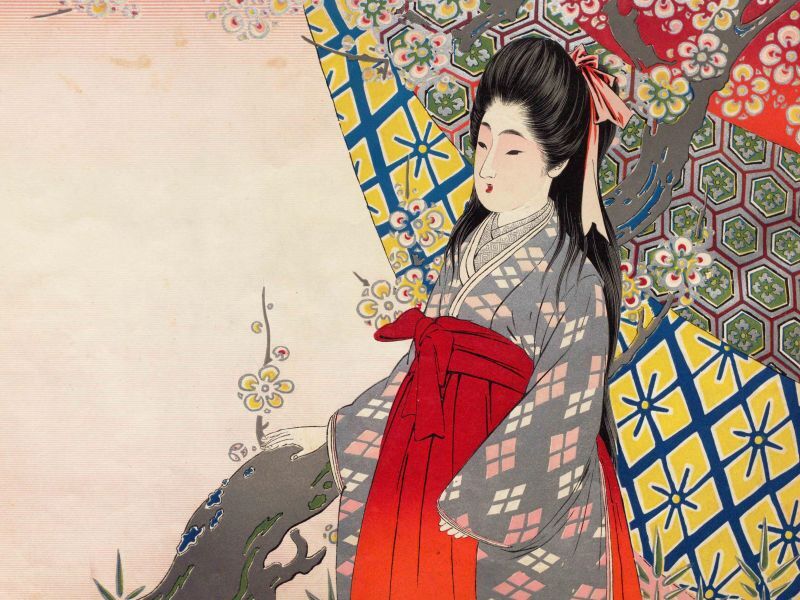History of Kimono - Meiji and Taisho period
The opening of the country to the outside world brought with it a sudden influx of Western culture, which had no small effect on fashion.
Modern silk mills were built with the help of the government's industrial development program and the production of silk increased further.
As a result, silk became less expensive and the variety of silk fabrics increased, including crepe, figured satin, OMESHI, and MEISEN.
With the development of dyeing techniques, the resulting fabrics were subjected to secondary processing, making it possible to create unprecedented yuzen patterns.
Furisode (long-sleeved kimono) made of pure silk also had smaller patterns, and the colors of the base were more subdued, and most of them were placed at the hem or the ends of the sleeves.
In the Meiji era, Maru Obi were made in plain colors such as brown and black, woven with double-sided zentsu(fully patterned).
For everyday wear, there were still remnants of the ban on extravagance, and simple cotton kimonos were the norm.
In the later half of the Meiji era (1868-1912), the base color gradually became brighter, the sleeve length became longer than before.
The colors of the hem patterns also increased. In addition, soft crepe began to be used as the fabric for kimonos.
The most common colors were navy blue, indigo blue, and the most common patterns were waterfall stripes, plaids, bar stripes, arrow kasuri, navy blue kasuri, and white kasuri.
During this period, haori, which had originally been men's clothing, became popular among women as well.
A major trend for both men and women was the outfits. For women, the Shirakiya kimono store began selling coats for winter protection, which drew a huge response.
Coordination between Japanese and Western styles, in which both men and women wore kimonos and combined Western items, also took root.
Men wore haori with hats and walking sticks, and items such as inverness, which were inspired by Western cloaks, were also introduced.
|
Another feature is the wearing of hakama. Hakama style became popular for both men and women.
Women's educational institutions opened one after another, and their school buildings used Western desks and chairs, which influences to women's hakama instead of kimonos, whose sashes and hems were easily disrupted. This style of hakama and laced-up boots became a symbolic style for female students, and is still favored for graduation ceremonies for female students today. |
|
| 新版引札見本帖. 第1 by National Dier Library Digital Collections |
After the middle of the Meiji era (1868-1912), the Western clothing boom that had been rapidly heating up began to cool down, and women in particular began to show a tendency to return to tradition.
Although people still wore kimonos in their daily lives, this was the era when Taisho Romanticism (*) blossomed, incorporating Western tastes in addition to kimonos.
In the early Taisho era, Kimono such as Omeshi, Meisen, Oshima Tsumugi, and Yellow Hachijo were favored, and the colors were mostly plain such as black and gray.
However, as time went on, kimono with bold patterns and flashy colors emerged, as well as Western-style designs that resembled Western clothing.
With the spread of chemical dyes and the influence of Art Nouveau, a pictorial style popular in Europe at the time, modern kimonos with vivid colors and beautiful curves became popular.
In the late Taisho period (1912-1926), kimonos influenced by the geometric Art Deco style were also produced, and abstract color patterns such as Meisen came to be worn as everyday wear.
At this time, the trend was to wear kimonos in a style that showed off a large, ornate patterned collar.
Haori, or long haori, were the leading fashion of the time.
It was also around this time that Homongi, the semi-formal dress of today, was born. It is said to have been created as the equivalent of a Western-style visiting dress, and was first sold by Mitsukoshi Department Store.
The design was more modest than that of furisode, but more flamboyant than that of everyday wear, and was favored as a convenient and fashionable dress.
However, this was not the case in terms of practical use.
When the Great Kanto Earthquake struck in 1923, many women who wore kimonos that were difficult to move around in suffered damage.
The following year, in 1924, the "Tokyo Women's and Children's Clothing Association" was established, and the westernization of women's clothing began to progress.
(*)Taisho Romanticism is a term used to refer to the trends and cultural events that convey the atmosphere of the Taisho era.
The Taisho era (1912-1926) was a time of individual liberation, a tendency to seek ideals for a new era, and an advanced culture that blended Japanese and Western influences, combined with the sweet and lyrical romanticism that flourished in literature and art until the end of the Meiji era. The term "romanticism" was coined to describe the sweet and lyrical romanticism that flourished in literature and the arts until the end of the Meiji period.
For kimonos, the colors and patterns created by the fusion of Japanese and European designs during the Taisho era are called Taisho Roman style.

